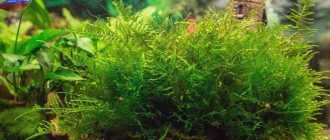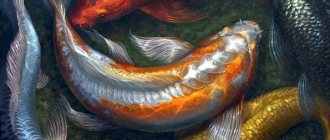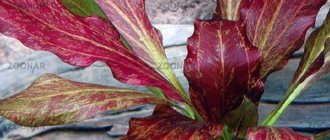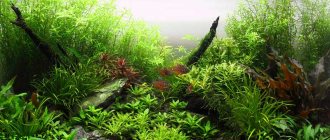For the greatest comfort, both for humans and fish, it is not enough to simply buy an aquarium and a couple of inhabitants. It is advisable to create a full-fledged underwater world.
Today there are no problems with materials for decoration. The most popular decoration is underwater mosses, which allow you to create not only amazing landscapes, but also have a beneficial effect on the quality of water and underwater inhabitants.
Maintenance and care
Green bubble moss develops on various types of soil and substrates. Therefore, the care procedure is simple. It includes a number of important processes, the observance of which determines the growth rate and brightness of color.
In an aquarium used for the propagation of mosses, appropriate conditions must be created.
• The water temperature in the tank is 18–27 degrees. • Carboxylic hardness and acidity are within normal limits. • Aquarium water is filtered regularly. After all, the growth rate of a plant decreases if suspensions, sediment, and harmful substances are present in the liquid. The selection of filters is carried out taking into account the phenotypes of fish and algae planted in the tank.
What is Java moss?
Visually, this is an interweaving of branching thin stems, which are literally strewn with tiny light green leaves, the largest of which are no more than 3 mm in size. In the usual sense, these stems do not have roots, and therefore moss is classified as the lower representatives of the flora.
It attaches to objects and surfaces using rhizoids - thin threads consisting of one or more simple cells that can only be seen with a microscope. It is through rhizoids that Java moss absorbs water and with it the nutrients necessary for growth. However, there is nothing unusual here, since such a structure is inherent in almost all mosses and lichens.
At first glance, Vesicularia dubyana seems to grow chaotically. But actually it is not. Upon closer examination, three levels of this aquatic vegetation can be seen:
the first level of stems tightly fits the substrate,
the second is horizontally growing stems, giving the whole bush a kind of small arched ceiling,
at the third level, the stems with leaves grow vertically, giving the whole plant its natural splendor.
Lighting
Growth intensity requires bright lighting (0.4–0.6 W/l). For this purpose, fluorescent and other lamps with the required characteristics are used. With this content, the color of bubble mosses improves.
The use of low-power lamps leads to a decrease in the growth rate of aquarium plants.
Bright lighting helps release more oxygen. This has a beneficial effect on the condition of individuals, shady plants and algae that are in the tank. Bryophytic species develop better.
When the lamp is selected correctly, small oxygen bubbles are formed. They are located on outgrowths, decorative elements and snags.
Java moss
Java moss is a common ornamental and very beautiful aquarium plant belonging to the hypnoid moss family.
The reasons for its popularity are its decorativeness, unpretentiousness, and the ability to be used as a spawning substrate for many spawning fish.
As the family and name of this plant suggests, it is indeed a moss, and mosses are not often found in home aquariums. It is classified very conditionally in the section of rooting plants; it has no roots and does not require soil.
Java moss fixes itself on the surface with the help of tiny suckers, invisible to the naked eye - rhizoids.
It is fixed very firmly and really looks like a rooted plant. You can grow it on driftwood or on a large decorative stone. The thickets of this plant are very decorative and create a real underwater jungle in the aquarium.
Amateur aquarists have known this plant for a long time; even in the USSR it was found in the middle of the last century. Widely distributed in nature in Southeast Asia.
It is a dense interweaving of thin small stems, completely dotted with tiny leaves, only a few millimeters in size. It is best to look at the appearance in the photo in the text.
Moss care
Water purified from harmful substances, nitrates and small particles is poured into the container in which the bubble moss is grown. For additional cleaning, mechanical filters and chemical cleaning compounds are used.
The water in the tank with such moss is changed every 6–10 days. Pour clean liquid into the aquarium.
Periodic aeration helps accelerate the growth of aquarium plants. For this purpose, special equipment, aerators, are used.
The vegetation of the bubbles must be cleared of algae, which actively spread over the surface, along the bottom and walls of the aquariums. Controlling their growth reduces the likelihood of dough rotting.
Mosses need feeding. For this purpose, mineral fertilizers and useful substances are used. They are sold in specialized stores.
Periodically add CO2 to the tank. The concentration is determined individually. To do this, the volume of the tank, the amount of plant dough, and the indicators of the aquarium water are taken into account. For an aquarium of non-standard shape, calculations are carried out separately.
Cleaning of leaves and outgrowths is done carefully. For these purposes, siphons and aerators are used. The procedure takes a little time. There is no need to make excessive efforts. After all, this can disrupt the integrity of the root system.
Cladophora globulus in the aquarium
Aquarists use cladophora not only as an aquascape element. The plant performs a number of useful functions:
- serves as an additional source of oxygen;
- is a natural filter, as it passes a large amount of water through itself, and, traveling through the aquarium, retains suspended matter, organic deposits, and the remains of uneaten food;
- among its threads, the simplest microorganisms develop, serving as starter food for fry of fish and small crustaceans;
- Shrimp like to clean thin filaments of aegagropyla from sediments.
Due to its ability to disintegrate at elevated temperatures, the algae is only suitable for aquariums with cold-water fish.
Compatibility
This plant goes well with almost all phenotypes of fish and algae. The exception is mollusks, which actively feed on such plants. You should not plant them with some algae that entwine the walls and decorative elements. After all, they are difficult to remove from the outgrowths.
The vegetation of this species is used by various shrimps, small fish, fry and some mollusks as protection. Shy fish, small snails and other mollusks lay their eggs in its depths.
Christmas moss
Aquarium mosses are represented by another interesting plant. The appearance resembles a Christmas tree, as the stems have thin leaves that become smaller towards the ends. Christmas moss is called "Christmas". At first glance, it resembles Javanese. If the water is hard and there is a lack of light, then the differences are invisible.
Christmas moss has no special requirements for conditions; the only requirement is to keep it in clean, flowing water. Standing and dirty water is detrimental to the plant. It needs to be cleaned regularly, otherwise it becomes covered with various residues and algae. The “saviors” are small shrimp that clean the stems and leaves, creating a mutually beneficial tandem. Do not forget to trim overgrown stems, otherwise the leaves in the shade will rot.
Breeding will not cause much trouble. It is enough to place a small piece of the stem in a new place and attach it. Christmas will grow and cover all the unevenness and flaws of the landscape design.
Reproduction
This type of vegetation reproduces by spores. They appear on the bush after 2–3 months. The number of spores is regulated as the plant quickly spreads throughout the tank.
Bubble moss is an interesting and original aquarium plant. With its help, experienced aquarists create amazing compositions. At the same time, maintaining the growth rate and color saturation is not difficult.
Video about moss bubble
AdminAuthor of the article
Did you like the article?
Share with your friends:
Description
Bubble are bryophyte perennial plants or bryophytes belonging to the class of true mosses. A distinctive feature of an underwater flower is its structure: the plant has lateral growths 5 cm long, similar to leaves, and rhizoids - root-like formations for attachment to the ground. The color of bryophyte is bright, rich green. With proper care and following simple maintenance rules, the plant grows into a beautiful bush, forming patterns with the help of branches and leaves. The unusual shape of the species persists for a long time. The plant does not require cutting or removal of overgrown parts, and when its lush branches are covered with air bubbles, the mossy flower looks like a real miracle.
The plant not only decorates the pond, but also brings great benefits:
- saturates water with oxygen;
- serves as shelter and food for fish and shrimp;
- is a place for phenotypes to multiply.
Bryophyte reproduces using spores, which appear after two to three months. Spores are formed on an adult bush, and their number varies depending on the age and lushness of the moss.
Breeding
Breeding corn snakes at home is quite possible. Sexual maturity in reptiles of this species occurs at the age of 2-3 years. Females mature a little later than males. Corn snakes are classified as oviparous snakes. Copulation is short-lived, lasting 10-20 minutes. After mating, after one to two months, the females lay eggs. You need to make sure in advance that there is a ditch with sphagnum next to it at this time. It is there that she will lay a clutch of 6-35 eggs. This is where the participation of the snake in the production of offspring ends. The eggs must be placed in an incubator where the temperature is maintained at 27-29 degrees. The incubation period is 50-75 days, after which small corn snakes hatch from the eggs, their length is approximately 200-240 mm. The babies will start feeding after the first molt.
Lighting
Corn snakes can survive without ultraviolet lighting. In practice, it is best to avoid placing the terrarium in direct sun, as this can lead to overheating and other unpleasant consequences. Normal lighting (fluorescent lamps) in the terrarium, preferably in a container, should not be placed in any lamps. Typically, maize snakes are managed on a 12 hour light/12 hour no light cycle.
Shelters
Snake shelter
One of the fundamental factors ensuring active feeding behavior is the presence of shelter in the terrarium. The corn snake, like most snakes, feels more comfortable when it has a place to hide and feels safe. The shelter should be of such a size that the snake can fit in completely, but at the same time close enough so that it touches its walls, curled up. A box of a suitable size with a small hole cut out on the side may be suitable as a shelter; shelters can also be purchased at pet stores. It is advisable to place two shelters: one in a warm corner of the terrarium, the second in a cold one, so that the animal does NOT have to choose between safety and thermoregulation. In some cases, corn snakes, which have no way to hide, begin to become stressed and refuse to eat.
This is interesting: What does a viper look like; common viper and other species, reproduction of poisonous snakes - we explain in detail
Moss decorations
Decorating an aquarium with moss allows you to create unique and spectacular underwater pictures. But this process requires hard work, thoroughness, it is very painstaking work.
Superglue, special threads, fishing line, and fine-mesh mesh are used for fixation.
When using glue, the composition is made outside the tank so as not to kill fish and other underwater inhabitants. In this case, the moss needs to be regularly sprayed with water and not allowed to dry out.
To create underwater compositions from Moss, you will also need other available means and tools: scissors, a sharp (for example, stationery) knife, special holders.
They try to distribute mosses over the selected surfaces in an even layer, avoiding layering of branches and creeping them on top of each other.
In order for the composition to look good, it is important to follow the following rules:
- Correctly adjust the nitrogen balance.
- Provide the necessary lighting.
- Regulate the cleanliness of the environment by timely updating of part of the volume and high-quality filtration.
- Timely use additional saturation with carbon dioxide and small doses of micro- and macro-fertilizer.
- Choose the right neighbors. For example, neons and tetras, swordtails, platies, mollies and, of course, shrimp, the true cleaners of these plants. Cichlids, algae eaters, and goldfish should be excluded.
The most popular among modern aquarists are compositions such as “Dense Forest” or “Underwater Slide”; a simple green wall also looks very beautiful.
The most famous decorator of artificial reservoirs in the world of today's aquarium hobby is Takashi Amano. It was he who introduced methods for saturating the reservoir with carbon dioxide, the use of natural shrimp aquatic organisms, special filtration systems and water conditioners, and many others.
The Japanese landscape photographer and aquarium artist created many unique aquascape paintings using Mosses and other aquatic plants, recreating the Amazon jungle, Chanthaburi mangroves, and underwater gardens of Zen temples.











